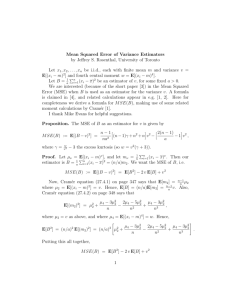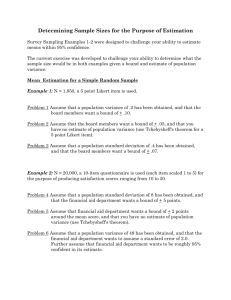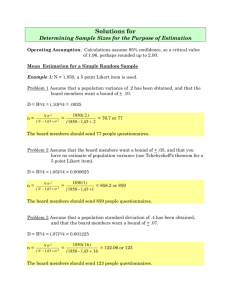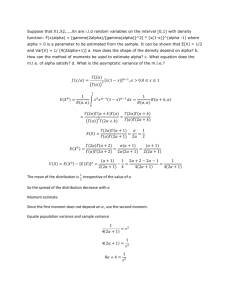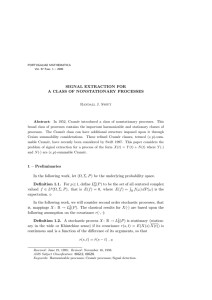E1 244: Homework
advertisement
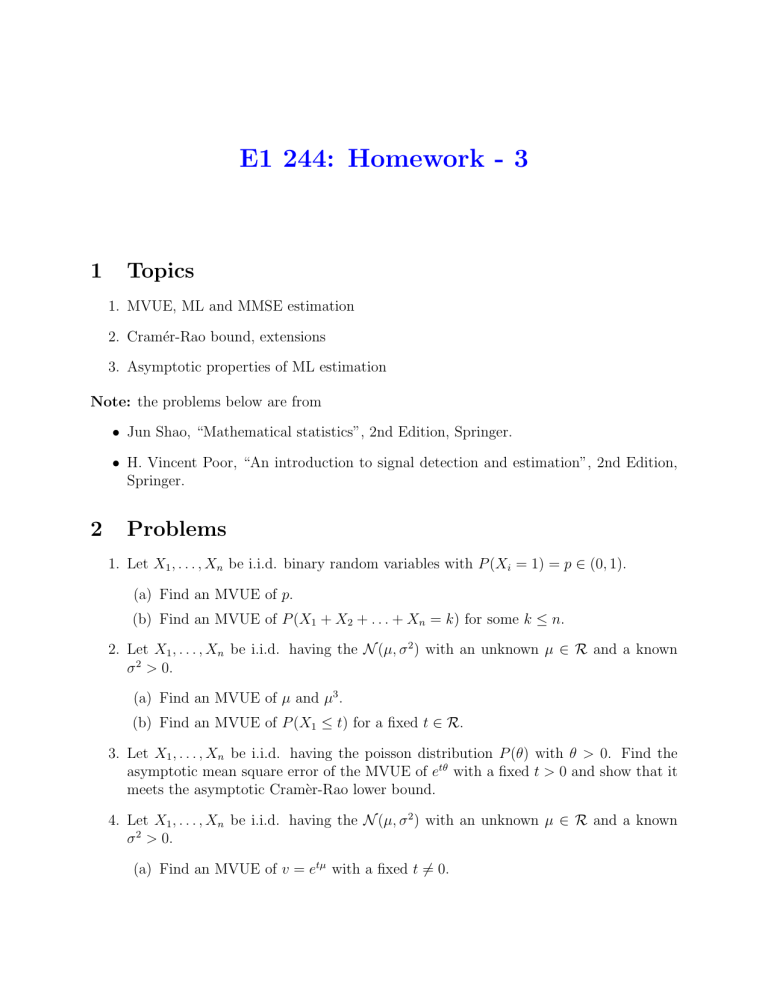
E1 244: Homework - 3
1
Topics
1. MVUE, ML and MMSE estimation
2. Cramér-Rao bound, extensions
3. Asymptotic properties of ML estimation
Note: the problems below are from
• Jun Shao, “Mathematical statistics”, 2nd Edition, Springer.
• H. Vincent Poor, “An introduction to signal detection and estimation”, 2nd Edition,
Springer.
2
Problems
1. Let X1 , . . . , Xn be i.i.d. binary random variables with P (Xi = 1) = p ∈ (0, 1).
(a) Find an MVUE of p.
(b) Find an MVUE of P (X1 + X2 + . . . + Xn = k) for some k ≤ n.
2. Let X1 , . . . , Xn be i.i.d. having the N (µ, σ 2 ) with an unknown µ ∈ R and a known
σ 2 > 0.
(a) Find an MVUE of µ and µ3 .
(b) Find an MVUE of P (X1 ≤ t) for a fixed t ∈ R.
3. Let X1 , . . . , Xn be i.i.d. having the poisson distribution P (θ) with θ > 0. Find the
asymptotic mean square error of the MVUE of etθ with a fixed t > 0 and show that it
meets the asymptotic Cramèr-Rao lower bound.
4. Let X1 , . . . , Xn be i.i.d. having the N (µ, σ 2 ) with an unknown µ ∈ R and a known
σ 2 > 0.
(a) Find an MVUE of v = etµ with a fixed t 6= 0.
(b) Determine whether the variance of the MVUE attains the Cramér-Rao lower
bound.
(c) Show that it meets an asymptotic Cramér-Rao lower bound.
5. Let X1 , . . . , Xn be i.i.d. having the exponential distribution E(a,θ) (x) = θ−1 exp(−(x −
a)/θ)1x≥a with parameters θ > 0 and a ∈ R.
(a) Find an MVUE of a when θ is known.
(b) Find an MVUE of θ when a is known.
(c) Find the MVUE’s of θ and a, when both parameters are unknown.
(d) Assuming that θ is known, find the MVUE of P (X1 ≥ t) for some fixed t > 0.
6. Let X be a sample from Pθ . Find the Fisher information matrix in the following cases:
(a) Pθ is the N (µ, σ 2 ) distribution with θ = µ ∈ R.
(b) Pθ is the N (µ, σ 2 ) distribution with θ = σ 2 > 0.
(c) Pθ is the N (µ, σ 2 ) distribution with θ = σ > 0.
(d) Pθ is the N (σ, σ 2 ) distribution with θ = σ > 0.
In all cases, assume that the unspecified parameters are “known”.
7. Suppose we observe a sequence Y1 , Y2 , . . . , Yn given by
Yk = Nk + θsk ,
k = 1, . . . , n
where N = (N1 , N2 , . . . , Nn )T is a zero mean Gaussian random vector with covariance
matrix Σ > 0; s1 , s2 , . . . , sn is a known signal sequence; and θ is a real non-random
parameter.
(a) Find the maximum-likelihood estimate of parameter θ.
(b) Compute the bias and variance of your estimate.
(c) Compute the Cramér-Rao lower bound for unbiased estimates of θ and compare
result from (b).
(d) What can be said about the consistency of θ̂M L as n → ∞ ? Suppose, for example,
that there are positive constants a and b such that
n
1X 2
s > a for all n
n k=1 k
and
λmin (Σ−1 ) > b for all n.
8. Consider the observation model
Yk = θ1/2 sk Rk + Nk
k = 1, . . . , n
where s1 , s2 , . . . , sn is a known signal, N1 , N2 , . . . , Nn , R1 , R2 , . . . , Rn are i.i.d. N (0, 1)
random variables, and θ ≥ 0 is an unknown parameter.
(a) Find the likelihood equation for estimating θ from Y1 , Y2 , . . . , Yn .
(b) Find the Cramér-Rao lower bound on the variance of unbiased estimates of θ.
(c) Suppose s1 , s2 , . . . , sn is a sequence of +1’s −1’s. Find the MLE of θ explicitly.
(d) Compute the bias and variance from estimate (c), and compare the latter with
the Cramér-Rao lower bound.
9. A formal definition of the consistency of an estimator is given as follows. An estimator
θ̂ is consistent if, given any > 0,
lim Pr{|θ̂ − θ| > } = 0.
N →∞
Prove that the sample mean is consistent estimator for the problem of estimating a DC
level A in white Gaussian noise of known variance. Hint: Use Chebyshev’s inequality.
10. If the data set
x[n] = As[n] + w[n] n = 0, 1, . . . , N − 1
is observed, where s[n] is known and w[n] is white Gaussian noise with known variance
σ 2 , find the MLE of A. Determine the PDF of the MLE and whether or not the
asymptotic normality theorem holds.
11. For N i.i.d. observations from N (0, 1/θ) PDF, where θ > 0, find the MLE of θ and its
asymptotic PDF.


